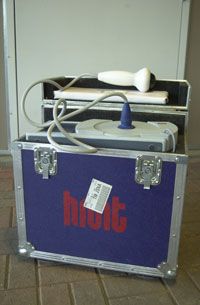Shockwave Therapy
 Shockwave Therapy is a non-invasive treatment that can speed the healing of many types of orthopedic and soft tissue injuries and conditions. It has been used in Europe in human medicine to treat tennis elbow, plantar fascitis (heel pain), rotator cuff injuries, calcifying tendonitis of the shoulder, femoral head necrosis (hip degeneration), non-union fractures, wounds, burns, osteomyelitis (infection of the bone) with draining tracts, and myofascial pain to name a few. New research has shown potential applications in treating periodontal disease, infected wounds, and to help speed fracture healing and reduce the incidence of non-union fractures. It has been approved by the U.S. Food and Drug Administration for use in people to treat plantar fascitis and tennis elbow that fail to respond to six months of conventional therapy.
Shockwave Therapy is a non-invasive treatment that can speed the healing of many types of orthopedic and soft tissue injuries and conditions. It has been used in Europe in human medicine to treat tennis elbow, plantar fascitis (heel pain), rotator cuff injuries, calcifying tendonitis of the shoulder, femoral head necrosis (hip degeneration), non-union fractures, wounds, burns, osteomyelitis (infection of the bone) with draining tracts, and myofascial pain to name a few. New research has shown potential applications in treating periodontal disease, infected wounds, and to help speed fracture healing and reduce the incidence of non-union fractures. It has been approved by the U.S. Food and Drug Administration for use in people to treat plantar fascitis and tennis elbow that fail to respond to six months of conventional therapy.
Shockwave therapy has been used in the U.S. in veterinary medicine for approximately 9 years. It has been used successfully to treat animals with both acute and chronic soft tissue unjuries, bone and joint disease, and back pain.
WHAT IS SHOCKWAVE?
A shockwave is a pressure wave – any action that displaces its surrounding medium is a shockwave. The ripple created when a stone is thrown into a pond is a shockwave. The shockwaves used in equine medicine are generated in a fluid medium inside a transducer head and are then transmitted readily through skin, fat, and muscle. The high energy waves are focused within the transducer head so that the shockwave can be directed to the precise area of the injury. When shockwaves hit an area of higher acoustic impedance, such as bone, the waves slow dramatically and a large amount of energy is released into the surrounding tissue.
DOES SHOCKWAVE WORK ON EVERY CASE?
No, there is no treatment that is successful in every case. Shockwave therapy is one of the most exciting therapies to become available to veterinary medicine in quite some time. It is extremely important to have an accurate diagnosis and a clearly defined area of injury in order to direct the shockwave to the appropriate area.
ARE ALL SHOCKWAVE MACHINES EQUAL?
Absolutely not. There are several machines currently marketed as shockwave machines that do not generate a true shockwave. They generate what is called a ballistic or radial wave. The physics of this type of wave are completely different from that of a true shockwave. A ballistic or radial wave is created when a projectile is rapidly accelerated by compressed air – it looks like a small jackhammer. The problem with this type of wave is that all of the energy is deposited at the skin, and the energy drops off rapidly as you move away from the skin. The result being that unless the injury is at the skin, the injured area is not receiving the necessary energy to help the healing process. Additionally, since the wave is not focused with this type of machine, the entire area around the treatment site is receiving the wave, which can potentially have harmful effects.
It is also important to recognize that not all focused shockwave machines are equal. There are now some focused shockwave machines on the market that advertise a deeper penetration of the shockwave into the tissue. The problem with these machines is that the focal zone for the release of the shockwave energy is so concentrated, almost like a pinpoint, that there is potential for tissue damage with this type of machine. Additionally, with this type of machine, because the focal zone is so small, there is a much greater likelihood of missing the desired target tissue or injury, thereby rendering the treatment useless or worse.
WHAT EQUIPMENT DOES OAKHILL USE?
Oakhill Shockwave uses a focused, electrohydraulic machine manufactured by Pulsevet. This machine is currently used in 18 different university veterinary hospitals and is largely considered to be state of the art. With this machine, the shockwaves are focused so that they can be directed precisely to the particular area of injury. Additionally, the energy level and the depth of penetration of the shockwaves can be varied to suit the injury.
All of the information on the shockwave therapy pages has been combined in a PDF for your benefit - download it here.
SHOCKWAVE FOR HORSES
SHOCKWAVE FOR SMALL ANIMALS